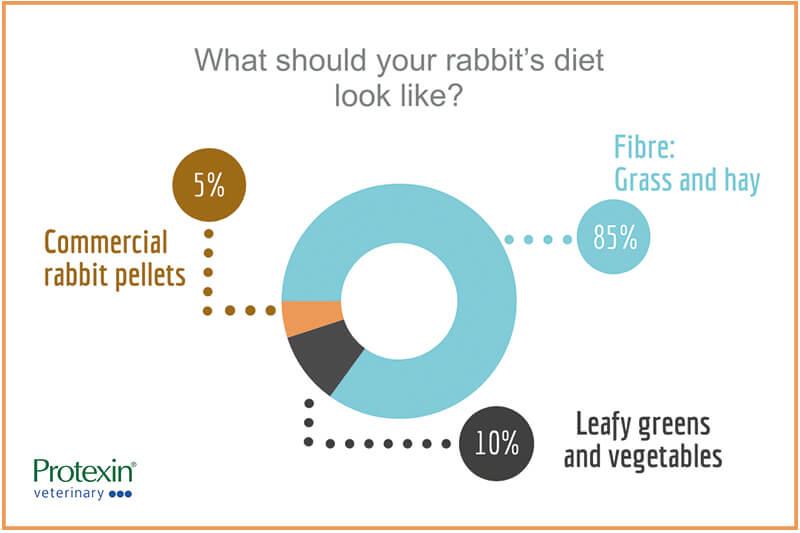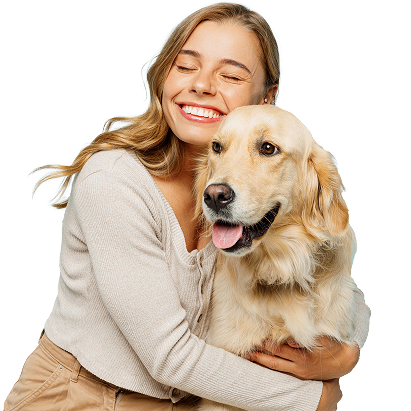Nutritional needs for rabbits
In the wild, rabbits rely on grass and other wild plants for all of their dietary needs. Their gut bacteria help to break down the plant-based fibre, fermenting it into products which the rabbit can absorb and use as a source of energy. The gut bacteria also produce certain vitamins which are essential to the bunny’s health. […]
In the wild, rabbits rely on grass and other wild plants for all of their dietary needs. Their gut bacteria help to break down the plant-based fibre, fermenting it into products which the rabbit can absorb and use as a source of energy. The gut bacteria also produce certain vitamins which are essential to the bunny’s health. It is clear to see that the relationship between a rabbit and its microbiota (gut bacteria) is very important. One way in which we, as owners, can support a healthy microbiota in our pet rabbits is by ensuring they are fed an appropriate diet.
What should your rabbit’s diet look like?
Fibre: grass and hay (85%)
High fibre content is absolutely essential when considering the diet of a rabbit. Fibre is fermented by the gut bacteria and the fermentation products then act as a direct food source for the rabbit. High fibre is also required for normal gut motility and to ensure that their teeth are kept worn down. Inadequate provision of fibre can result in overgrown teeth, reduced gut motility and even gut stasis, which can make a rabbit very poorly.
Fibre can be provided in several forms, but the most natural and most common are grass or hay. While grass is preferable, given that it would constitute the majority of a wild rabbit’s diet, hay is a good substitute and is available all year round and for indoor rabbits. Good quality hay should smell sweet and be free of mould and excessive dust.
Did you know?
- Alfalfa hay is not made from grass and is much richer, so should only be offered as a treat in moderation.
- ‘Complete diets’ are not a substitute for hay, but a nutritional supplement to be offered alongside grass/ hay.
- Grass cuttings should not be given to rabbits as they ferment quickly and can then be harmful to bunnies.
- Grass/ hay should make up ~ 85% of your rabbit’s diet, and an unlimited supply should be provided.

Leafy greens and vegetables (10%)
There are a large number of plants other than grass which are also safe for bunnies to eat. Examples include dandelions, basil, peppers and leaves from apple trees or blackberry bushes. It is best to offer a variety and give only a small amount of each plant at a time. All plants collected from the wild should be thoroughly washed before consumption, it is also important to ensure your rabbit’s myxomatosis and HDV vaccines are up to date to avoid disease transmission from wild rabbits.
Fruits and carrots may be given to bunnies, however, due to their high sugar content they should only be given as a treat once or twice a week.
For a more extensive list of rabbit-friendly foods please see the RWAF recommended vegetables and herbs list. Of course, it is important to avoid any poisonous plants. For further information on this topic see a list of plants to avoid.
Commercial rabbit pellets (5%)
Rabbits offered muesli-style food will often pick out the tastiest pieces which tend to be highest in sugar. In order to avoid this selective feeding, it is recommended to stick to pelleted or extruded-style rabbit foods.
Pellets should make up about 5% of your rabbits diet. For a 2.5kg rabbit, this is 1 egg cup-full given twice daily.
Treats
Manufactured treats are often high in sugar and are best avoided. High sugar diets can disrupt the delicate balance of bacteria present in your rabbit’s guts, which are essential for normal digestion.
The best treats for your bunny are small amounts of varied vegetables – as suggested above. Alternatively, they’ll love some parsley, coriander or broccoli to munch on!
Water
Finally, as with all other animals, rabbits should always have access to fresh water. Water is particularly important for rabbits in order to keep their guts and urinary systems functioning normally. Ensure bottles are always flowing freely, bowls are regularly cleaned and re-filled and that water does not freeze in winter.

How to monitor your rabbit’s diet
A rabbit fed a healthy diet should eat well and produce lots of dry round faecal pellets. If you see lots of wet stools/ caecotrophs in their hutch or enclosure this is a sign your rabbit is not eating these poos directly from their bottom as they should do. While this may occur if they are fed a diet too rich in sugar/ carbohydrates and lacking in fibre, there are also other reasons such as arthritis, meaning it is painful to reach around to their back end, and obesity, meaning it is not physically possible for them to do so.
If you are concerned or notice wet stools or caecotrophs lying around, it is best practice to get them checked by your vet.
 Pet Owner
Pet Owner 



